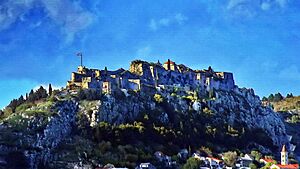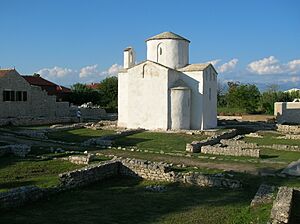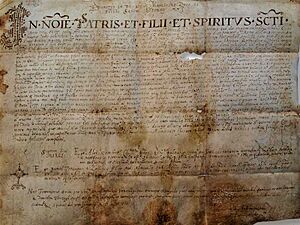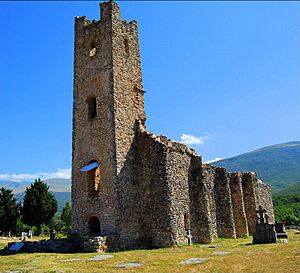Duchy of Croatia facts for kids
Quick facts for kids
Duchy of Croatia
|
|||||||||||
|---|---|---|---|---|---|---|---|---|---|---|---|
| 7th century–c. 925 | |||||||||||
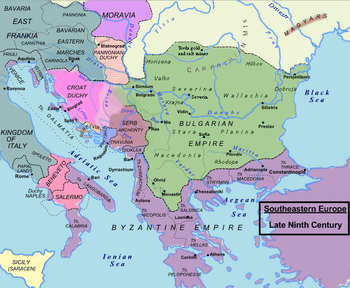
Southeast Europe c. 850; Duchy of Croatia is shaded pink.
|
|||||||||||
| Capital | No permanent seat Nin Klis Bijaći Solin Knin |
||||||||||
| Common languages | |||||||||||
| Religion |
|
||||||||||
| Demonym(s) | Croats | ||||||||||
| Government | Duchy | ||||||||||
| Duke | |||||||||||
|
• early 7th century
|
"Father of Porga" and Porga (first Archons) | ||||||||||
|
• 810–821
|
Borna (first known Duke) | ||||||||||
|
• 910–925
|
Tomislav (last Duke) | ||||||||||
| Historical era | Middle Ages | ||||||||||
|
• Established
|
7th century | ||||||||||
|
• Frankish vassalage
|
790s | ||||||||||
|
• Papal recognition
|
7 June 879 | ||||||||||
| c. 925 | |||||||||||
|
|||||||||||
| Today part of | |||||||||||
The Duchy of Croatia (also known as the Duchy of the Croats) was an important state in the Middle Ages. It was founded by the White Croats who moved into the area of what used to be the Roman province of Dalmatia around the 7th century.
This duchy was located in the coastal part of today's Croatia, except for Istria. It also included a large part of the mountains inland. The Duchy of Croatia was often caught between two big powers: the Carolingian Empire (Franks) and the Byzantine Empire. It also had rivalries with Venice and fought battles with the Bulgarian Empire and the Arabs.
For some time, Croatia was under the control of the Franks or Byzantines. But in 879, Duke Branimir was recognized as an independent ruler by Pope John VIII. The Duchy was led by the Trpimirović and Domagojević families from 845 to 1091. Around 925, under Duke Tomislav, Croatia became a kingdom.
Contents
What Was It Called?
Historians today sometimes call the Duchy "Dalmatian Croatia" or "Littoral Croatia." It's also sometimes called the "Principality of Croatia."
The first recorded name for this state was "Land of the Croats" (regnum Croatorum) in 852. At that time, Croatia was not yet a kingdom. The word regnum just meant a country in general. In Byzantine writings, it was usually simply called "Croatia."
The first known duke, Borna, was called "Duke of Dalmatia." Later, he was called "Duke of Dalmatia and Liburnia." Croatian documents from the late 800s also used the name. For example, Trpimir I was called "Duke of the Croats" in 852. Branimir was also called "Duke of the Croats" on an old stone carving.
Where Was It Located?
The Duchy of Croatia was in the area of the old Roman province of Dalmatia. Different Slavic groups lived along the Adriatic coast. Early medieval Croatia stretched from the eastern Adriatic coast inland. It included parts of western Herzegovina, western and central Bosnia, and areas like Lika and Gacka. It also went northwest to Vinodol and Labin on the coast.
Some important coastal cities like Split, Zadar, Kotor, and Dubrovnik were under Byzantine rule. So were islands like Hvar and Krk. To the south, Croatia bordered the land of the Narentines. This area included islands like Brač and Korčula. Further south were other regions like Zahumlje and Dioclea (today's Montenegro). North of Croatia was the Duchy of Lower Pannonia.
Like other early medieval states, Croatia did not have one permanent capital city. Croatian dukes lived in different places. Early important centers included Klis near Split, where Duke Trpimir I lived. Other dukes ruled from Solin, Knin, Biaći, and Nin.
History of the Duchy
How It Started

In the 7th century, much of Dalmatia was controlled by the Avar Khaganate. These were nomadic people who ruled over Slavic tribes. In 614, the Avars and Slavs attacked and destroyed Salona, the capital of Dalmatia.
The earliest Croatian leaders mentioned were the father of Porga and Porga himself. After fighting the Avars, the White Croats either moved into Dalmatia because the Byzantine Emperor Heraclius invited them, or they moved there on their own after defeating the Avars. By the early 9th century, Croatia became a political state with a duke as its leader. It was divided into 11 areas called županija (counties).
Even though Croats started becoming Christian soon after they arrived, some were still pagan in the early 9th century.
Under Frankish Influence
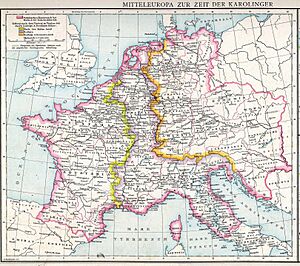
The Franks took control of Pannonia and Dalmatia in the late 700s and early 800s. In 788, Charlemagne conquered Lombardy and then moved east to control Istria. In the 790s, Duke Vojnomir of Pannonia accepted Frankish rule. The Franks tried to extend their power over the Croats in Dalmatia. In 799, the Franks were defeated in the Battle of Trsat.
However, by 803, most of northern Dalmatia recognized Frankish rule. The Franks also fought wars with the Byzantine Empire. They signed a peace treaty in 812, called the Pax Nicephori. This treaty meant the Byzantines kept control of coastal cities and islands in Dalmatia. The Franks ruled over Istria and the inland parts of Dalmatia.
Around 810, Borna, who lived in Nin, ruled most of northern Dalmatia. He was a vassal (a ruler who owes loyalty to a more powerful king) of the Carolingian Empire. Borna was the Duke of the Guduscani, a Croatian tribe. His rule saw the rebellion of Ljudevit Posavski against the Franks. Ljudevit defeated Borna in 819 but was later forced to retreat. Borna died in 821 and was followed by his nephew Vladislav.
Caught Between Empires
The Duchy of Croatia was located between two big powers: the Eastern Roman Empire (Byzantines) in the East and the Franks in the West. The Byzantines controlled the Dalmatian cities and islands. They wanted to rule the entire old Roman province of Dalmatia. The Franks wanted to control the northern and northwestern lands. Byzantine influence also affected Croatian law and trade with the Byzantine coastal cities.
In the mid-800s, the Croats started building a navy. Along with the Narentines, who were still pagan (not Christian), they became active in the Adriatic Sea. This made shipping dangerous, especially for Venice. So, in 839, the Venetians attacked the Adriatic coast, including Croatia. But they signed a peace treaty with the Croatian ruler, Duke Mislav. The Doge (leader) of Venice also attacked Narentine islands but failed to defeat them. Piracy continued in the Adriatic.
Duke Mislav was followed around 845 by Trpimir I. He was still officially a vassal of the Frankish king, but he made his own rule stronger in Croatia. Arab attacks weakened the Byzantine Empire and Venice. Trpimir used this to his advantage. In 846, he attacked Byzantine coastal cities. Between 854 and 860, he successfully defended his land from an invasion by the Bulgarians under Knyaz Boris I of Bulgaria. They made a peace treaty and exchanged gifts. Old writings mention the long-standing friendship between Bulgarians and Croats.
In a Latin document from 852 (or around 840), Trpimir called himself "leader of the Croats with the help of God." He called his land the "Realm of the Croats." This shows he felt independent, even though he wasn't a king yet. This document also shows he owned the Klis Fortress, which was his main base. Trpimir built a church and the first Benedictine monastery in Croatia. He is known as the founder of the House of Trpimirović, a Croatian family that ruled Croatia for a long time.
In 864, Duke Domagoj took the throne after Trpimir died. He forced Trpimir's sons to flee. During Domagoj's rule, piracy was common in the Adriatic. Pirates even attacked a ship carrying church officials. The Pope asked Domagoj to stop the piracy, but it didn't help. Domagoj fought wars with the Arabs, Venetians, and Franks. In 871, he helped the Franks take Bari from the Arabs. But later, he rebelled against Frankish rule and succeeded. This ended Frankish control in Dalmatia. After Domagoj died in 876, Zdeslav, who had ties to Byzantium, returned and took the throne. He made peace with Venice in 878.
Becoming Independent
Duke Zdeslav's rule was short. In 879, Branimir killed him and took the throne. Branimir was a supporter of Rome and brought the country back under Roman influence. He regularly communicated with Pope John VIII. Branimir told the Pope he wanted to put his people and country under the Pope's care. The Pope responded positively. In 879, the Duchy under Branimir became free of Frankish control and was recognized as a state by the Pope.
The late 9th century saw the Pope's influence grow in Southeastern Europe. Pope John VIII asked Dukes Zdeslav and Branimir to help protect his messengers who were traveling through Croatia to Bulgaria. This suggests that Croatia and Bulgaria shared a border, probably somewhere in Bosnia.
Muncimir, Trpimir's youngest son, became duke after Branimir died around 892. This brought the House of Trpimirović back to power. A Latin document from 892 called Muncimir "Duke of the Croats." During his rule, in the late 9th century, the Hungarians moved into the Carpathian Basin. They invaded northern Italy and defeated the Duke of Pannonia, which put Croatia in danger.
Muncimir ruled until about 910. Then, Tomislav became duke. He was the last duke and the first king of Croatia. A Venetian writer mentioned that in 912, a Venetian ambassador traveled through Croatian territory on his way from Bulgaria. This suggests that Croatia still bordered Bulgaria at that time.
An old chronicle from the 13th century mentioned Tomislav as Duke of Croatia in 914. According to another historical text, De Administrando Imperio, Croatia at that time had a very large army and navy. While these numbers are likely exaggerated, they show that Croatia was seen as a strong military power. Croatia also fought battles with the Magyars (Hungarians) in the early 10th century.
During the war between the Byzantines and Bulgaria, around 923, the Byzantines made an alliance with Croatia. The Bulgarians had won many battles against the Byzantines. In 924, the Bulgarian ruler Simeon I removed the ruler of Serbia, who then fled to Croatia. In 926, Simeon's troops invaded Croatia but were badly defeated in the Battle of the Bosnian Highlands. In 927, Pope John X sent his messengers to help make peace between the Croats and Bulgarians.
During these years, Croatia became a kingdom. It is generally believed that Duke Tomislav was crowned king in 925. We don't know exactly when or where he was crowned, or if he was crowned at all. However, Tomislav was the first Croatian ruler whom the Pope's office called "king." Tomislav is mentioned as a king in two old documents. In a note from the Council of Split in 925, it says Tomislav is the king "in the province of the Croats and in the Dalmatian regions." In a letter from Pope John X, Tomislav is called "King of the Croats." Even if there are no direct stone carvings from Tomislav confirming his title, later carvings and documents confirm that his successors in the 10th century called themselves "kings."
See also
- History of Croatia
- Croatian–Bulgarian Wars
- Dukes of Croatia


